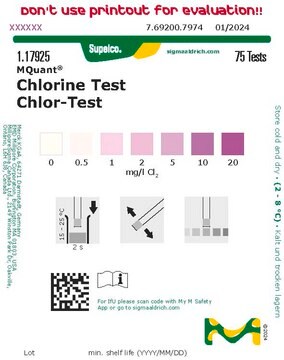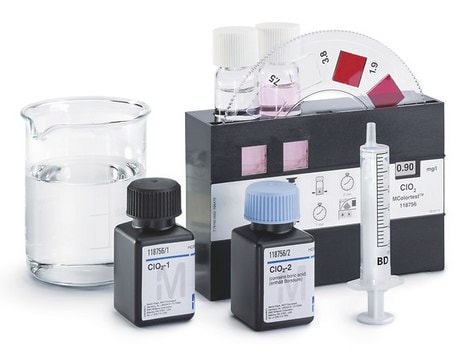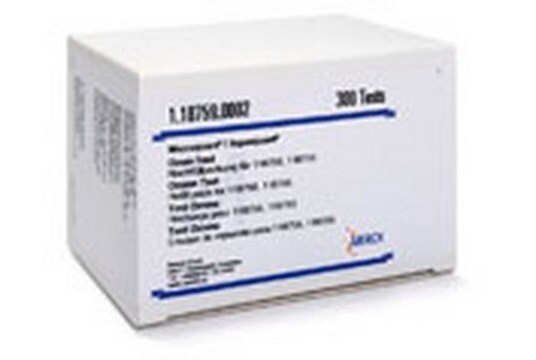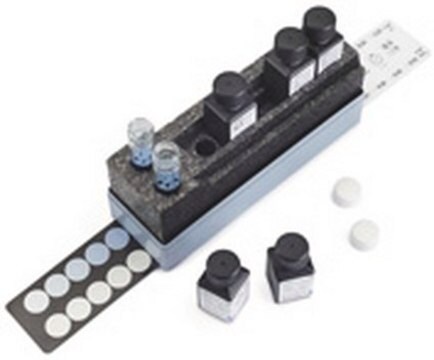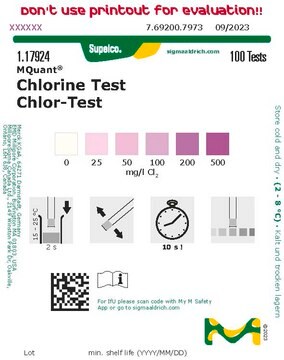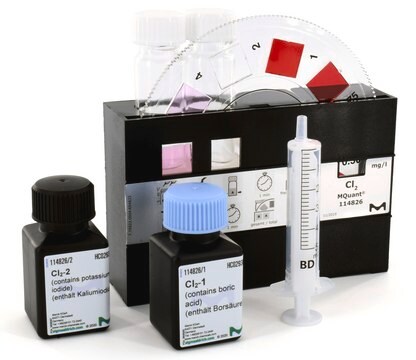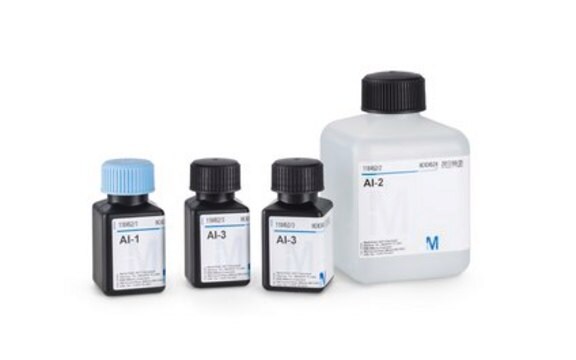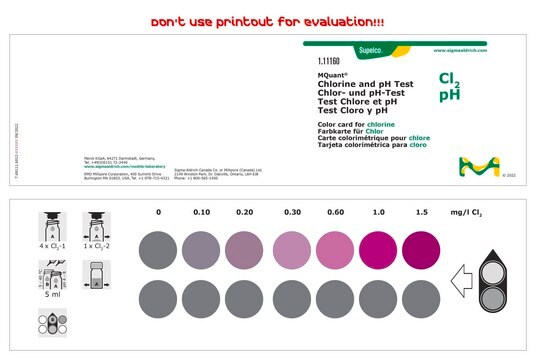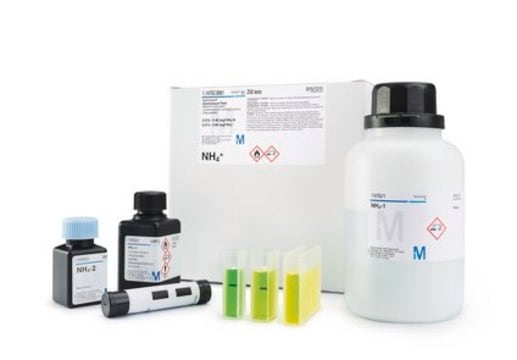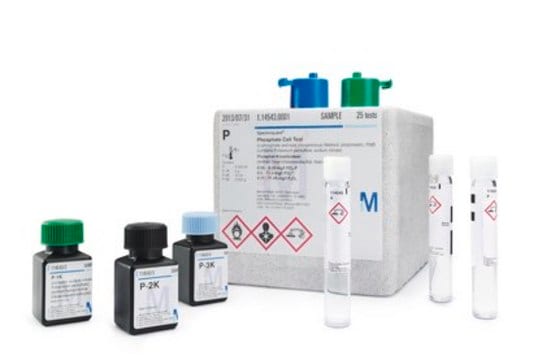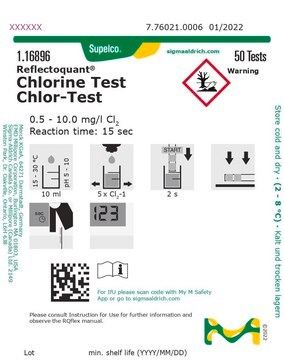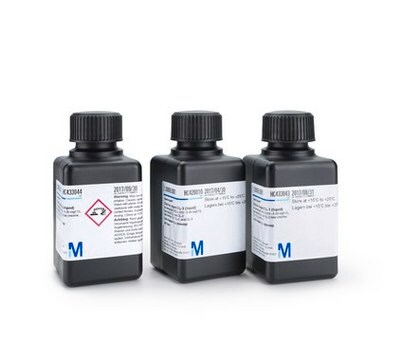1.14978
Chlorine Test Kit, colorimetric
0.1-2.0 mg/L (Cl₂), MQuant®
Synonyme(s) :
Chlorine Visual Test Kit
About This Item
Produits recommandés
product name
Chlorine Test, colorimetric, 0.1-2.0 mg/L (Cl2), for use with MQUANT®
Gamme de produits
MQuant®
Niveau de qualité
Analyte(s) spécifique(s)
chlorine
Plage de mesure
0.1-2.0 mg/L (Cl2)
Compatibilité
for use with MQUANT®
Méthode de détection
colorimetric
Température de stockage
15-25°C
Description générale
The test can be used in
- Groundwater and surface water
- Drinking water and mineral water
- Waters from aquaculture
- Wastewater
- Electroplating wastewater
- Disinfectant solutions
This test is not suited for seawater.
Method
In weakly acidic solution free chlorine reacts with diethyl-p-phenylenediamine (DPD) to form a red-violet dye. In the presence of potassium iodide, also combined chlorine is measured in this reaction. The chlorine concentration is measured semiquantitatively by visual comparison of the color of the measurement solution with the color fields of a color disk.
The test evaluates the color reaction based on the transmitted light method. So even turbid and colored water samples can be analyzed without further preparation.
The color disk is made of very durable, lightfast plastic, thus suitable for industrial areas and wet environments.
Using the refill pack 1.14979 containing all the reagents, the original test kit can be used for a very long time, making it a particularly economical and ecological system.
Application
- Water Treatment and Disinfection: Chlorine testing is crucial for ensuring the safety and effectiveness of water disinfection processes. Accurate measurement of free chlorine and total chlorine levels is essential to maintain appropriate disinfection while minimizing the formation of harmful disinfection by-products (DBPs). Recent studies have focused on the kinetics of chlorine reactions in seawater and their impact on biocidal effectiveness and environmental safety (Kinani et al., Critical Reviews in Analytical Chemistry, 2022).
- Environmental Monitoring: Chlorine testing is used to monitor chlorine levels in various environmental matrices, such as rivers, lakes, and wastewater. This is essential to assess the impact of chlorination on aquatic ecosystems and to ensure compliance with environmental regulations. Advanced chromatographic and mass spectrometric techniques are employed to speciate chlorine-produced oxidants and their by-products in seawater (Roumiguières et al., Critical Reviews in Analytical Chemistry, 2023).
- Public Health and Drinking Water Safety: Ensuring the safety of drinking water is a primary concern. Chlorine testing helps to maintain the right balance of chlorine for effective pathogen control while avoiding excessive chlorination that could lead to health risks. Analytical methods, including titrimetric and colorimetric methods, are used to measure residual chlorine in drinking water to ensure it meets safety standards (Ko et al., Chinese Journal of Analytical Chemistry, 2022).
- Industrial Applications: Chlorine testing is essential in various industrial processes where chlorine is used, such as in the production of paper and textiles, and in cooling water systems. Accurate monitoring of chlorine levels helps in optimizing these processes and ensuring compliance with safety and environmental regulations (Kinani et al., Critical Reviews in Analytical Chemistry, 2022).
- Photochemical Degradation Studies: Chlorine testing is also used in research studies involving the photochemical degradation of pollutants. For example, the use of UV/free chlorine processes in degrading pharmaceuticals in aqueous solutions has been investigated using response surface methodology to optimize conditions for maximum efficiency (Arman et al., International Journal of Environmental Analytical Chemistry, 2022).
Informations légales
Mention d'avertissement
Danger
Mentions de danger
Classification des risques
Eye Dam. 1 - Met. Corr. 1 - Skin Corr. 1A
Code de la classe de stockage
8A - Combustible, corrosive hazardous materials
Classe de danger pour l'eau (WGK)
WGK 2
Certificats d'analyse (COA)
Recherchez un Certificats d'analyse (COA) en saisissant le numéro de lot du produit. Les numéros de lot figurent sur l'étiquette du produit après les mots "Lot" ou "Batch".
Déjà en possession de ce produit ?
Retrouvez la documentation relative aux produits que vous avez récemment achetés dans la Bibliothèque de documents.
Les clients ont également consulté
Protocoles
AQA Standard for free chlorine - Preparation of a standard solution for free chlorine
Preparation of a standard solution for free Chlorine according to DIN EN ISO 7393
Contenu apparenté
AQA Standard for free chlorine - Preparation of a standard solution for free chlorine
Notre équipe de scientifiques dispose d'une expérience dans tous les secteurs de la recherche, notamment en sciences de la vie, science des matériaux, synthèse chimique, chromatographie, analyse et dans de nombreux autres domaines..
Contacter notre Service technique